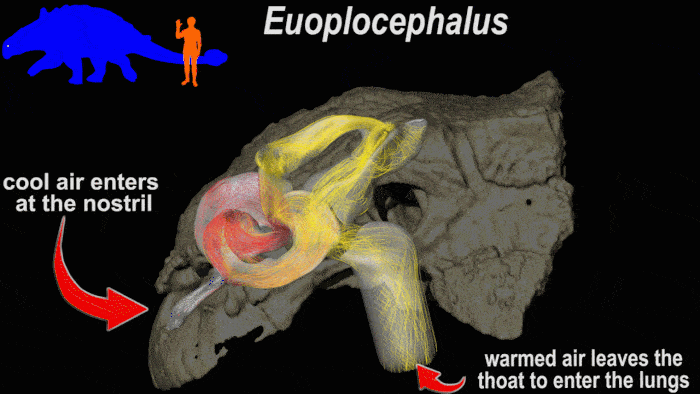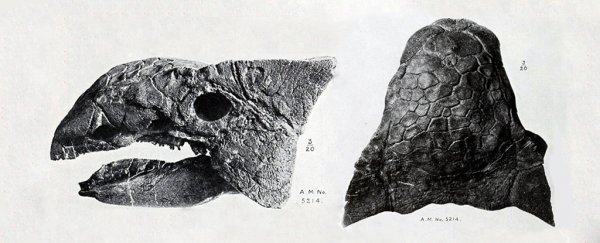The late Cretaceous, which ended 66 million years ago, was a rough-and-tumble time. Dinosaurs like Ankylosaurus left reminders of brutishness in their fossilized armor. Spikes sprouted from their shoulders. Row after row of bony plates covered their backs. With low and well-protected bulks, tipping the scales at a ton or more, they were built like battle tanks.
Their heads, in contrast to their backs, lack drama. Other dinosaurs have ornate frills and crests or jaws full of banana-size chompers. Not the armored dinosaurs, with their boxy and small heads.
Even dinosaur fans "don't usually think much about" these skulls, said Jason M. Bourke, a vertebrate paleontologist at the New York Institute of Technology.
Or, at least, they hadn't, until some of Bourke's colleagues, led by Lawrence M. Witmer at Ohio University, digitally pried open an ankylosaur skull. What the paleontologists found, according to a study published Wednesday in the journal PLOS One, can explain how these walking tanks avoided boiling their brains under the prehistoric sun.
Using a CT scanner - the same technology as found in medical centers - Witmer tracked long, twisty airways that curled like "crazy straws," Bourke said.
No one knew what these nasal loops were for. Perhaps the convolutions aided vocalizations, or gave the animals a superior sense of smell.
There was a third possible explanation, which biologists call thermoregulation. Most vertebrate animals must maintain their bodies within a narrow band of temperatures.
For smaller animals, especially those in cold climates, thermoregulation is often viewed as preventing heat loss. But large animals, who hold in lots of heat, have the opposite problem.
Delicate organs like brains are particularly important to keep cool. "Neural structures really don't like undergoing rapid changes in temperature," Bourke said. The armored dinosaurs must have been particularly vulnerable.
Not only were they bulky, which means they accumulated lots of body heat, but their smallish brains had a high ratio of surface area to volume, which means the heads could gain or lose heat readily. It wouldn't take much to fry an ankylosaur noggin.
Bourke and Witmer, along with Wm. Ruger Porter, a postdoctoral researcher in Witmer's lab, recently created a detailed computer model to follow heat as it passes through the animals' noses. Bourke, who conducted this work as part of his graduate research at Ohio University, is the first person to use computational fluid dynamics to model dinosaur nose tissues.
Thanks to CT scans of fossilized skulls that retained soft tissue, the scientists reconstructed the passageways and blood vessels of two armored dinosaur species. When they unwound the nasal crazy straws in digital space, the passages, stretched end to end, were 1.4 to 2 times as long as the dinosaurs' skulls.
They also estimated how much energy it would take for a dinosaur to warm a breath of Cretaceous air, estimated to be about 60 degrees, to a body temperature of around 35 degrees Celsius (95 Fahrenheit). Those temperatures are very rough estimates, but logical ones.
"Estimates for things like body mass, lung volume and body temperature, which feed into the parameters of the model, are justified based on the supporting literature," said Caleb M. Brown, a paleontologist at the Royal Tyrrell Museum in Canada who was not involved with this work. Anyway, he said, the exact numbers aren't important.
"It is these overall trends that are important."
To heat a single breath to the body temperature of an Euoplocephalus, an ankylosaurian dinosaur, required more than 1.5 calories. (About three breaths would burn the calories in a cup of lettuce.)
Put another way, the looping passages draw heat from blood vessels. This warmed the air headed to the lungs while cooling the blood near the airway.
A network of vessels, the study authors said, shuttled that chilled blood back toward the brain, like coolant water piped through a power plant.
This model "shows quite convincingly that the convoluted nasal passages of both armored dinosaurs would have efficiently warmed and moistened air on inhalation, and cooled and dried air on exhalation," Brown said.  (Witmer Lab/Ohio University)
(Witmer Lab/Ohio University)
Though this is strong support for the thermoregulation hypothesis, the scientists haven't ruled out multiple uses. Perhaps the winding noses lowered the timbre of their calls, too, Bourke said.
Armored dino respiration was different from that in the largest animals alive today. An ankylosaurus the size of a rhino probably breathed about a third as frequently. Sucking in air through these passages meant it took a long time for air to get to lungs. Bursts of high activity would have been difficult.
"They probably didn't have to do a lot of running," Bourke said. In the rare instance when these dinosaurs had to skedaddle, it's possible that the ankylosaurs became mouth-breathers.
2018 © The Washington Post
This article was originally published by The Washington Post.
